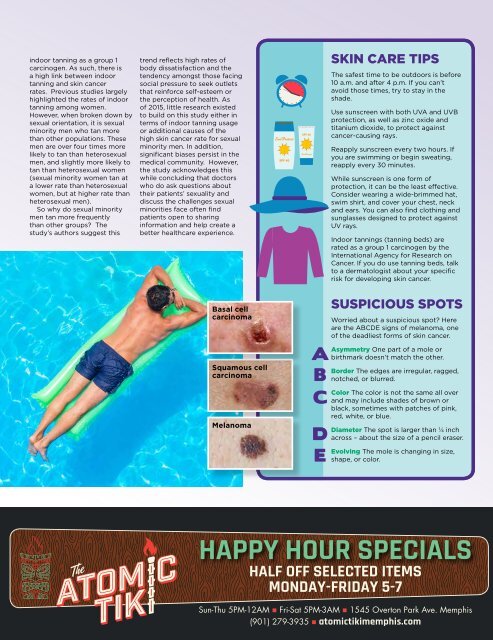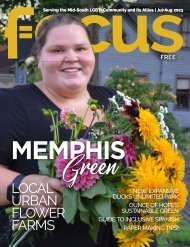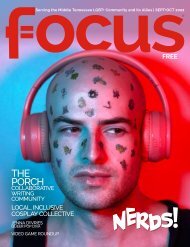2018 Issue 4 Jul/Aug - Focus Mid-South Magazine
- No tags were found...
You also want an ePaper? Increase the reach of your titles
YUMPU automatically turns print PDFs into web optimized ePapers that Google loves.
indoor tanning as a group 1<br />
carcinogen. As such, there is<br />
a high link between indoor<br />
tanning and skin cancer<br />
rates. Previous studies largely<br />
highlighted the rates of indoor<br />
tanning among women.<br />
However, when broken down by<br />
sexual orientation, it is sexual<br />
minority men who tan more<br />
than other populations. These<br />
men are over four times more<br />
likely to tan than heterosexual<br />
men, and slightly more likely to<br />
tan than heterosexual women<br />
(sexual minority women tan at<br />
a lower rate than heterosexual<br />
women, but at higher rate than<br />
heterosexual men).<br />
So why do sexual minority<br />
men tan more frequently<br />
than other groups? The<br />
study’s authors suggest this<br />
trend reflects high rates of<br />
body dissatisfaction and the<br />
tendency amongst those facing<br />
social pressure to seek outlets<br />
that reinforce self-esteem or<br />
the perception of health. As<br />
of 2015, little research existed<br />
to build on this study either in<br />
terms of indoor tanning usage<br />
or additional causes of the<br />
high skin cancer rate for sexual<br />
minority men. In addition,<br />
significant biases persist in the<br />
medical community. However,<br />
the study acknowledges this<br />
while concluding that doctors<br />
who do ask questions about<br />
their patients’ sexuality and<br />
discuss the challenges sexual<br />
minorities face often find<br />
patients open to sharing<br />
information and help create a<br />
better healthcare experience.<br />
SKIN CARE TIPS<br />
The safest time to be outdoors is before<br />
10 a.m. and after 4 p.m. If you can’t<br />
avoid those times, try to stay in the<br />
shade.<br />
Use sunscreen with both UVA and UVB<br />
protection, as well as zinc oxide and<br />
titanium dioxide, to protect against<br />
cancer-causing rays.<br />
Reapply sunscreen every two hours. If<br />
you are swimming or begin sweating,<br />
reapply every 30 minutes.<br />
While sunscreen is one form of<br />
protection, it can be the least effective.<br />
Consider wearing a wide-brimmed hat,<br />
swim shirt, and cover your chest, neck<br />
and ears. You can also find clothing and<br />
sunglasses designed to protect against<br />
UV rays.<br />
Indoor tannings (tanning beds) are<br />
rated as a group 1 carcinogen by the<br />
International Agency for Research on<br />
Cancer. If you do use tanning beds, talk<br />
to a dermatologist about your specific<br />
risk for developing skin cancer.<br />
Basal cell<br />
carcinoma<br />
Squamous cell<br />
carcinoma<br />
Melanoma<br />
SUSPICIOUS SPOTS<br />
Worried about a suspicious spot? Here<br />
are the ABCDE signs of melanoma, one<br />
of the deadliest forms of skin cancer.<br />
Asymmetry One part of a mole or<br />
birthmark doesn’t match the other.<br />
Border The edges are irregular, ragged,<br />
notched, or blurred.<br />
Color The color is not the same all over<br />
and may include shades of brown or<br />
black, sometimes with patches of pink,<br />
red, white, or blue.<br />
Diameter The spot is larger than ¼ inch<br />
across – about the size of a pencil eraser.<br />
Evolving The mole is changing in size,<br />
shape, or color.<br />
HAPPY HOUR SPECIALS<br />
HALF OFF SELECTED ITEMS<br />
MONDAY-FRIDAY 5-7<br />
Sun-Thu 5PM-12AM • Fri-Sat 5PM-3AM • 1545 Overton Park Ave. Memphis<br />
(901) 279-3935 • atomictikimemphis.com


















